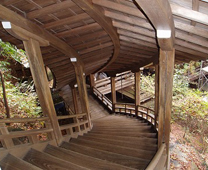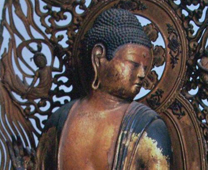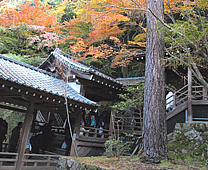
Travel Guide
Introduction
Zenrinji Temple was establised in the 863. Originally Zenrinji Temple was a villa of a court noble in the Heian Period, but was donated to become a Shingon Buddhist temple. In the 13th century it changed to the Jodo, or Pure Land, sect. It is the head temple for the Seizan branch of Japan's Jodo-shu (Pure Land) Buddhist sec.
Zenrinji Temple is famous for its fall foliage and the evening illuminations that take place in fall, makes the temple the autumn color viewing point in Kyoto. The temple is also known for its prominence in the past as a center of learning.
The temple buildings are spacious and beautiful, and elegant covered wooden walkways connect them all together. There is even a curving staircase called Garyuro that climbs up the side of the hill behind the temple. Another attractive spot is the Hojo Pond, around which an attractive garden has been cultivated. Small streams run through the temple grounds and connect to this main pond, at the center of which is a small shrine on an island. Visitors can also enjoy walking around the grounds.
There is a Tahoto pagoda high up on the hill that is beautiful to look at, and you can climb all the way to it, too. From the top, you have a view of the entire temple complex and the hills of Kyoto in the distance. The sight is particularly impressive in autumn, when leaves turn the whole hill in a flamboyant flare of red, orange and yellow colors.
Zenrinji Temple means “Temple in a calm grove,” but the temple is commonly referred to as "Eikan-do" after a famous head priest named Eikan. Eikan is attributed with acquiring the unusual Amida Buddha statue in the main worship hall. The head is turned sideways, and the legend goes that originally the statue faced forward, but turned to speak to Eikan as he was walking by.
History
The temple got its start when Kukai's pupil, the monk Shinsho, aspired to found a temple for the worship of the Gochi Nyorai, or Five Wisdom Buddhas. In 853, he purchased the mansion of Fujiwara no Sekio for this purpose. The construction of temples was forbidden in Kyoto at the time, however, and so it was not until ten years later, when formal Imperial approval was granted by Emperor Seiwa, that the Zenrinji Temple was formally founded.
Though originally devoted to the Shingon sect, beginning in the time of Yokan (永観, 1033-1111), the seventh head monk, the temple began to shift towards Jodo-shu, a sect formally established roughly a century later in 1175. Yokan had trained in a number of temples of different disciplines in Nara, and was a passionate devotee of the Amida Buddha. In 1072, he established a Yakuo-in (薬王院) on the grounds, which organized giving to the needy and caring for the ill. He also introduced the practice of Nenbutsu, a Chinese practice which was quite new in Japan, into the temple, and cultivated its observance among the monks and devotees.
Zenrinji Temple has grown famous for its unusual statue of the Amida Buddha, which looks over its shoulder, rather than straight ahead. In Japanese this is called the Mikaeri Amida. According to tradition, at one point in 1082, when Yokan was fifty, he and a number of monks were practicing a ritual, walking around the statue and reciting sutras when the statue of Amida came to life and stepped down from its dais. Yokan halted the ritual in surprise; the Buddha looked over its shoulder at the monk, and said to him, "Yokan you are slow". Ever since then, goes the story, the posture of this statue has remained in that position. Alternate versions of the story involve the Buddha joining the monks in a ritual dance.
The twelfth head of the temple, Johen (1166-1224), originally a Shingon monk like the rest at Zenrinji Temple, was a disciple of Honen, one of the founders of Jodo-shu; Johen was thus the first head of Zenrinji Temple to be a formal devotee of this emerging sect. He was succeeded as head monk by Shoku (1177-1247), and it was under Shoku's successor, Shoon (1201-1271), that the temple formally became devoted to Jodo-shu.
Treasures
In addition to the famous Amida statue, which is designated an Important Cultural Property by the Japanese government, there are a great many cultural treasures stored in Zenrinji Temple's Tahoto. These primary consist of paintings of a variety of Buddhist subjects, including images of Amida, Shakyamuni, Yakushi Nyorai, and the Parinirvana of the Buddha. Paintings by Kano Motonobu, Tosa Mitsunobu, and Hasegawa Tohaku are also kept by the temple.
The wooden Amida statue is 77 cm in height, and though for a long time believed to date from the Kamakura period (1185-1333), is now thought to have been carved somewhat earlier in the 12th century (Heian period, 794-1185). This change in dating came about with the comparison to Song dynasty (960-1279) sculptures in Sichuan Province which show strong similarities in style. Zenrinji Temple's Amida statue was formally named an Important Cultural Property in 1999.
 |
 |
 |
| Garyuro | Mikaeri Amida | Garyuro and Sanko-no-matsu |
Travel Advice
|
|||
Visit
| Address | 48 Eikando-cho, Sakyo-ku, Kyoto-shi, Kyoto | |
| Phone | 075-761-0007 | |
| Admission | Adult: 600 yen Student: 400 yen |
Adult: over 18 Student: 6 to 17 Group tickets are available |
| Hours | 09:00 to 17:00 | Entry until 1 hour before closing Night visit will be held during the autumnal exhibition |
| Closed | Open 7 Days a Week | |
| Duration | 40 minutes | |
| Getting There | By Train 15 minute walk from Exit No.1 of Keage Station on subway Tozai Line. Take City Bus No.5 from JR Kyoto Station to the Nanzenji and Eikando-do bus stop, then walk approximately 3 minutes. Take City Bus No.100 from JR Kyoto Station to the Higashitennocho bus stop, then walk approximately 5 minutes. By Car Take Meishin Expressway to the Kyoto-higashi exit. It is approximately 6 kilometers 30 minutes from exit. |
|
| Parking | Parking available | |

